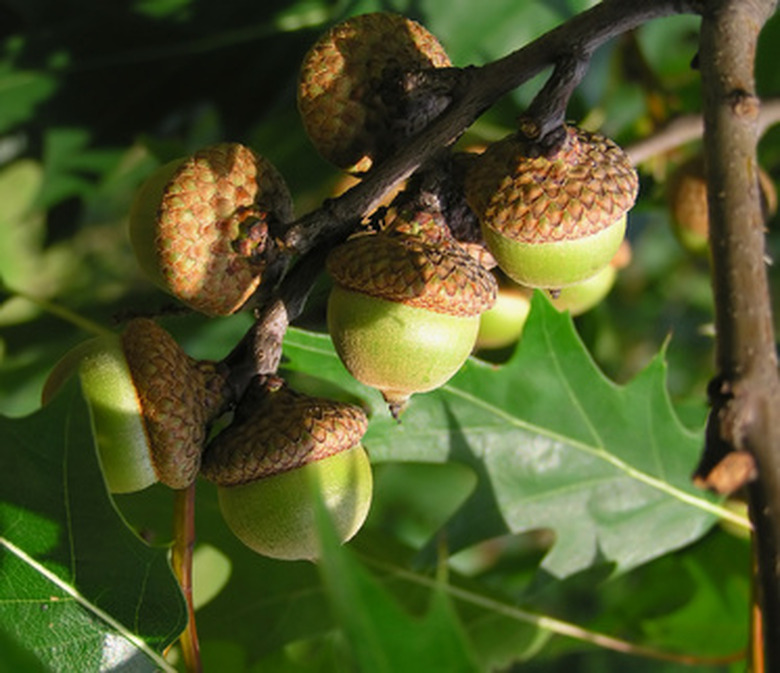The Best Oak Trees For North Carolina
The oak is stately in appearance and has interesting foliage and squirrel-attracting acorns. No wonder North Carolinians insist on having them in their parks, gardens, campuses and cemeteries. Many native and non-native oak species prosper in North Carolina. From the western mountains and Piedmont to the sandy coastal plain to the east, there is an oak tree to suit your needs.
White Oak
Slowly growing into a massive, monstrous shade tree, white oak (Quercus alba) will grow anywhere in the state as long as soil is not soggy. A deep, fertile and acidic soil is best, but white oak is adaptable.
Scarlet Oak
Vivid burgundy and red fall foliage makes scarlet oak (Quercus coccinea) popular for parks and large gardens. It also is fast growing in all regions and soils of North Carolina.
- The oak is stately in appearance and has interesting foliage and squirrel-attracting acorns.
- Vivid burgundy and red fall foliage makes scarlet oak (Quercus coccinea) popular for parks and large gardens.
Water Oak
Appropriate for all parts of the state, water oak (Quercus nigra) produces rapid growth to become a large, round-canopied shade tree.
Pin Oak
If you do not mind persistent brown foliage in winter, the pin oak (Quercus palustris) is fast growing. It makes a great shade tree, but because of low branches it should not be used as a street tree across North Carolina.
Willow Oak
Sometimes incorrectly called "pin oak" because of the narrow, linear leaves, willow oak (Quercus phellos) makes a spectacular shade or street tree that is in scale with residential houses. It is tolerant of heat, drought and compacted soils, growing fastest in moist acidic soil statewide.
Live Oak
The quintessential tree of the American South, live oak (Quercus virginiana) is best in eastern North Carolina, within 150 miles of the Atlantic Ocean. Slow growing, it needs a spacious lawn or landscape. In unusually cold winters the foliage may fully drop off, and along the coast the salt spray can diminish this tree's beauty.
- Appropriate for all parts of the state, water oak (Quercus nigra) produces rapid growth to become a large, round-canopied shade tree.
- Sometimes incorrectly called "pin oak" because of the narrow, linear leaves, willow oak (Quercus phellos) makes a spectacular shade or street tree that is in scale with residential houses.
Overcup Oak
Producing large acorns, the overcup oak (Quercus lyrata) is great for compacted soils of many different pH levels. It forms a perfected rounded canopy and is perfect for parking lot or highway medians.
Laurel Oak
Laurel oak (Quercus hemisphaerica) has colorful spring new foliage, and is only partially deciduous in fall and winter. Use it as a park or shade tree in infertile, compacted or dry soils statewide.
Southern Red Oak
Southern red oak (Quercus falcata) tolerates infertile, wasteland soils, anywhere where the soil never is soggy and other large shade trees fail. It grows statewide.
Non-Native Oaks
Native to Asia, sawtooth oak (Quercus acutissima) is good in well-draining acidic soils. The English oak (Quercus robur) tolerates dry soils but may have fungal problems on the leaves because of the humidity. More difficult to find and purchase, both Chinese evergreen oak (Quercus myrsinifolia) and blue Japanese oak (Quercus glauca) from Asia are best in the eastern two-thirds of the state. Japanese evergreen oak (Quercus acuta) should be grown only in the sandy coastal plain in the east.
- Producing large acorns, the overcup oak (Quercus lyrata) is great for compacted soils of many different pH levels.
- Southern red oak (Quercus falcata) tolerates infertile, wasteland soils, anywhere where the soil never is soggy and other large shade trees fail.
References
- North Carolina State University: Large Trees for North Carolina
- Western N.C. Nature Center: Trees of Western North Carolina
- "Dirr's Trees and Shrubs for Warm Climates"; Michael A. Dirr; 2002
